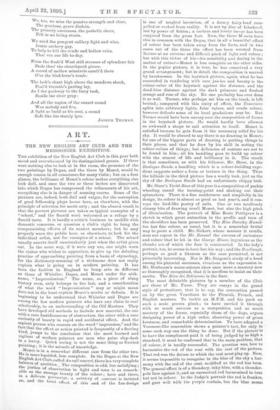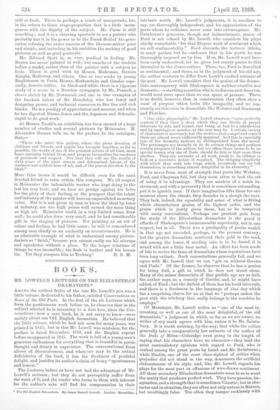ART
THE exhibition of the New English Art Club is this year both saved and overwhelmed by its distinguished guests. If there were nothing else to look at in the room, the presence of the two paintings by Degas, and the three by Monet, would be -enough reason in all conscience for many visits ; but on a first glance, the brilliance of Monet's colour makes everything else look dull, and once the two or three inches are discovered into which Degas has compressed the refinements of his art, everything else is in danger of seeming coarse. Some of the pictures are, indeed, both dull and vulgar, for the corruption of good fellowship plays havoc: here, as elsewhere, with the principle of selection for merit only ; and the absurd result is that the poorest pictures are taken as typical examples of a "school," and the flaccid work welcomed as a refuge by a flaccid taste. It is hardly a critic's business to meddle with domestic concerns, or question a club's right to hang the compromising efforts of its weaker members; but he may properly warn the public here, as elsewhere, to look for the individual artist, not for examples of a school.. The school usually asserts itself unmistakably just when the artist gives out. In the same way, if it were any use, one might warn the visitor who wishes to appreciate, to give up the deluding practice of approaching painting from a basis of etymology, for the dictionary-meaning of a nickname does not really explain what is going on in modern painting. It has been the fashion in England to lump arts so different as those of Whistler, Degas, and Monet under the nick- name, "Impressionism." The name, as a piece of slang history even, only belongs to the last, and a consideration of what the word " Impressionism " may or might mean does not in the least explain Monet'a merits or defects. It is beginning to be understood that Whistler and Degas are among the few modern painters who have any claim to real Scholarship, to an understanding of the Old Masters. They have developed old methods to include new material, the one with a rare fastidiousness of abstraction, the other with a rare curiosity of beauty in rapid and accidental effect. And the sapient person who reasons on the word" impression," and the fact that the effect or action painted is frequently of a fleeting kind, iunalis to the conclusion that the most learned and vigilant of modern painters are men who paint slap-dash in a hurry. Quick seeing is not the same thing as flurried painting ; it is the miracle of knowledge.
lie is in a somewhat different case from the other two. H is more lopsided, less complete. In the Degas at the New English Art Club, called Att cafei balance of qualities. concert, there is a very complete The composition is odd, but satisfying ; the j ustice of obaeivation in light and tone is as remark- able as the strange beauty of the colour ; here and these, in a delieete postscrinf, a sehtlety of contour is insisted on, and the total etieet of this and of the fan-design is one of magical invention, of a dainty fairy-land com- pelled or evoked from reality. It is not by dint of falsehood, but by power of fiction; a curious and lovely imege has been conjured from the gross fact. Now, the three Manets have this in common with the Degas, that in all a beautiful area of colour has been taken away from the facts, and in two cases out of the three the effect has been wrested from Nature at an extreme and difficult pitch of light and colour ; but with this virtue of his—his sensibility and daring in the matter of colour—Monet is less complete on the other sides. In the poplar picture, it is true, he has conceived a very grand arrangement; but in detail, the composition is marred by harshnesses. In the haystack picture, again, what he has succeeded in rendering with rare justice and beauty is the colour-value of the haystack against the distance, and the dead-blue distance against the dark primrose and flushed orange and rose of the sky. No one probably has ever done it so wall. Turner, who perhaps set him on the track, is left behind ; compared with this unity of effect, the Temeraire splits into arbitrary lights, false values, and crude colour, however delicate some of its local gradations may be. But Turner would have been uneasy over the composition of forms in the haystack picture. He would hardly have allowed so awkward a shape to call attention to itself. Monet is satisfied because he gets from it the necessary relief for his sky. It would be absurd to say there is no drawing in Monet; for one of the biggest parts of drawing is putting things in their places, and that he does by his skill in noting the colour-values of things; but delicacies of contour are not to be found in him; all his handling goes to build up colour with the utmost of life and brilliancy in it. The result is that sometimes, as with his follower, Mr. Steer, in the Boulogne Sands, a handling which is a colour-building expe- dient suggests rather a form or texture in the thing. Thus the hillside in the third picture has a woolly look, just as the sky of the Boulogne Sands had an unfortunate chippy look.
Mr. Steer's Yacht-Bace of this year is a composition of yachts wheeling round the turning-point and shaking out their spinnakers. There is a fine suddenness and simplicity in its design, its colour is almost as good as last year's, and it con- veys the bird-like poetry of sails. One or two needlessly clumsy bits of drawing recall Monet, but also the high pitch of illumination. The portrait of Miss Rosie Pettigrew is a sketch in which great animation in the profile and turn of the shoulders has been preserved. The Miss Dorothy Hamil- ton has fine colour, as usual, but it is a somewhat brutal way to paint a child. Mr. Sickest. whose manner it recalls, does not repeat in the Mr. Roussel the success of caricature and colour that he hit in the George Moore, ingenious as the chunks are of which the face is constructed. In the lady's portrait, too, be seems to have lost his way ; and the Bradlaugh, perhaps as good a likeness as the case permitted, is not pictorially interesting. Nor is Mr. Sargent's study of a head among his pictorial successes, vivacious as the expression is. Mr. Brabazon's water-colours show once more a mastery now so thoroughly recognised, that it is needless to insist on their merits. The Biva doi Solelavonl is the finer.
The most debatable pictures by a member of the Club are those of Mr. Purse. They are essays in the grand style of portraiture, that is to say, the convention passed on by the great Venetians to the Flemish, French, and English masters. To tackle an M.F.H. and his pack on such a scale proves pluck ; to have carried it through with so much success as a composition and so much mastery of the forms, especially those of the dogs, argues designing power of a high order, observing power of great keenness, and remarkable determination. To have adopted a Veronese-like convention shows a painter's tact, for only in some such way can the thing be done. But if the picture is to have the compliment paid it of being judged by so high a standard, it must be confessed that in the main problem, that of colour, it is hardly successful. The question was, how to harmonise the red of the coat with the rest of the picture. That red was the datum to which the rest must play up. Now, it seems impossible to recognise in the blue of the sky a hat% mony with the red of the coat. modified as the red has been. The general effect is of a thundery, inky-blue, with a thunder- pale face against it, and an unresolved red harmonised in tone but not in colour. In the judge's portrait the red is franker, and goes well with the purple curtain, but the blue seems still at fault. There is, perhaps, a touch of masquerade, too, in the return to those stage-properties that is a little incon- gruous with the dignity of the subject. Mr. Furse is still searching ; and it is a cheering spectacle to see a painter who probably has it in his power to be the Frank Holl of his gene- ration refusing the easier success of the likeness-maker pure and simple, and including in his ambition the making of good pictures as well as good portraits.
Mr. Edward Stott is, as ever, poetical in feeling. Mr. Brown, has never painted so well; but smacks of the student before a model, rather than of the painter with a subject he feels. There is good work by Messrs. Muhrman, Buxton Knight, Holloway, and others. One or two works by young Englishmen in Paris, Messrs. Rothenstein and Conder espe- cially, deserve notice. In black-and-white there is a vigorous study of a scene in a Russian synagogue by Mr. Pennell, a clever sketch by Mr. Townsend, and one or two examples of the freakish talent of Mr. Beardsley, who has fancy and designing power, and technical resources in fine line and rich blacks. He is a prodigy of appreciation and manner, and when he has digested Burne-Jones and the Japanese and Schwabe, ought to do good work.
At Messrs. Tooth's, an exhibition has been opened of a huge number of studies and several pictures by Meissonier. M. Alexandre Dumas tells us, in the preface to the catalogue, that,—
" Those who enter this gallery, where the pious devotion of children and friends and pupils has brought together, as far as possible, the works of one of the greatest artists of all time, must leave curiosity behind them, and prepare themselves for emotions of gratitude and respect. For here they will see the results of sixty years of the most sincere and determined labour, of the warmest and noblest love of art, and of the purest devotion to the ideal."
More false issues it would be difficult even for the most devoted friend to raise within this compass. We all respect in Meissonier the indomitable worker who kept doing to the last his very best; and we have no grudge against his heirs for the piety of their feeling, or the prospect that the talent and industry of the painter will have an unparalleled monetary value. But it is not given to man to know the ideal by force of industry, nor are high prices well earned the same thing as high art. Meissonier could, in a very limited sense, draw well ; he could also draw very small, and he had considerable gift in the staging of pictures. For painting as an art of colour and feeling, he had little sense; he will be remembered among men chiefly as an authority on accoutrements. He is an admirable example of what is understood among picture- dealers as "finish," because you cannot easily see his stirrups and epaulettes without a glass. To the larger relations of things he was insensible ; his flesh is leather and his horses tin. Yet they compare him to Terburg I D. S. M.







































 Previous page
Previous page